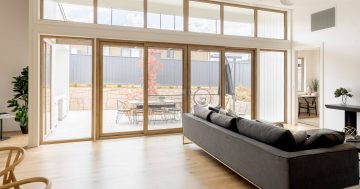
North-facing rooms are the only places you can “control the sun” at home. Photo: Commonsense Sustainability Solutions.
In the early afternoon, it’s a nippy 12 degrees out. Inside Paul Nagle’s home, it’s a balmy 26 – and he doesn’t have the heating on.
Every weekend for six months following its official opening on 7 August, the public will be welcomed in to see how he does it.
The Energy Efficient Demonstration Home was built at the edge of Ginninderry’s Strathnairn Display Village, but with a different motivation than the other homes on display.
“Our aim in building this home on the edge of the display village was not to sell homes,” Paul says.
“The purpose of this build was to provide an educational resource, which shows visitors firsthand how they can easily achieve energy efficient, sustainable solutions in their own homes.”
But SEE Change’s Jodie Pipkorn, who will run the public tours, says the location isn’t coincidental.
“We wanted to be on the edge of a display village so we’d capture passers-by who are thinking of building new homes,” she says.
“People viewing display homes want to touch and see things before they build, but a lot of the display homes don’t focus on the energy efficiency principles for consumers.”
With a background in architecture, Jodie says sustainability considerations have pleasant manifestations in the home, and early design decisions can have lasting impacts on this.
She says a lot of energy inefficiency is due to unnecessary airflow affecting insulation, and the solutions are simple – almost painfully so – when incorporated from the outset.









As she takes visitors through the “demo home”, they will see sections of wall deliberately exposing construction techniques she hopes will become the new building standards.
“It’s required by building code to add a sort of breathable wall wrap around a building that holds in insulation, but we took more care with how we sealed those wraps,” she says.
“Usually this wrap is stapled, leaving gaps air can flow through. Instead, we used an extremely high-grade tape on all joins so you don’t get airflow penetrating that wrap.”
Other common opportunities for airflow to sneak past insulation include around pipes, wiring and the gaps around windows.
Many of these gaps are structurally necessary, but simple solutions used to get around this at the Energy Efficient Demonstration Home include foam, pressure tape and opting for pendant lights instead of downlights.
But perhaps most importantly, Jodie talks through concepts of positioning, the role of optimal materials and the science behind thermal mass.
“The main living space and bedrooms all face north – the one direction where you can ‘control’ the sun. In winter it’s lower in the sky and reaches all the way up to the kitchen,” she says.
“Then we have an eave outside at the correct height to keep the sun out in summer, when it’s high in the sky.
“We also have burnished concrete floors, so when the sun hits the floor, the concrete soaks that heat up during the day and releases it at night.”
Other nifty interior tricks include “reverse brick veneer” walls, energy-efficient appliances and sustainable materials, creating zoned spaces with “cavity sliding doors” and using thermally broken double- and triple-glazed windows with good sealing componentry designed in Europe.
The house is fitted with solar panels and batteries so on those “outlier times” when the house needs a little help with temperature, the solution is electric.
Outside, a recycled plastic grid hides under a grass driveway, preventing erosion and sinking and allowing for lush growth that will not only absorb rain in extreme wet weather conditions but reduce the “urban island heating effect”. The same goes for the “green roof” and even the choice of exterior paint colours.
The Energy Efficient Demonstration Home will open for guided tours at 11 am, 1 pm and 3 pm on most Saturdays and Sundays from 13 August until the end of the year. Visit the Commonsense Sustainability Solutions website to confirm opening times and view a suite of demonstration videos here.





















